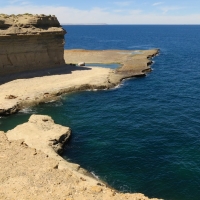 It is Sunday and still early, but outside it is already buzzing. Next to our tent the flamingos are splashing around in the pond, in the tree above us dozens of birds are chirping and in the garden we hear Jorge humming gently while he sweeps the driveway. Outside the walled garden cars drive up and down the street, neighbours greet each other and music sounds from the house next door. Life in Azul has already begun early on this Sunday morning, even though a local party in town went on very long last night. The daily rhythm of the Argentines is quite different from ours.
It is Sunday and still early, but outside it is already buzzing. Next to our tent the flamingos are splashing around in the pond, in the tree above us dozens of birds are chirping and in the garden we hear Jorge humming gently while he sweeps the driveway. Outside the walled garden cars drive up and down the street, neighbours greet each other and music sounds from the house next door. Life in Azul has already begun early on this Sunday morning, even though a local party in town went on very long last night. The daily rhythm of the Argentines is quite different from ours.
They wake up early, work until about one o’clock and then close the shutters during the siesta. Literally and figuratively, because the offices and shops close and the people lie down for a nap after their lunch. The siesta lasts until about 6 o’clock in the evening. After that, the shops open again and the people resume their work for a few hours, after which everybody returns home for dinner. By the time us Dutchies have eaten and go to bed after a cup of tea with a cookie, the Argentines just begin to eat their starters. Together with their children, who stay up just as late, they again enjoy a meal before they finally go to bed.
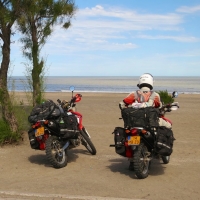 The first days in South America, we had to get used to the long siesta. We found ourselves in front of closed stores with an empty stomach several times. Back at the tent we would take out all the food we still had and would eat a lunch of cookies, chips and boiled eggs. Meanwhile, the South American rhythm of life begins to sink in. Peter especially likes the afternoon nap.
The first days in South America, we had to get used to the long siesta. We found ourselves in front of closed stores with an empty stomach several times. Back at the tent we would take out all the food we still had and would eat a lunch of cookies, chips and boiled eggs. Meanwhile, the South American rhythm of life begins to sink in. Peter especially likes the afternoon nap.
Today, he will have to do without the afternoon nap, because we are getting on the road again. We pack the tent, write a message in the guestbook of La Posta and start our motorbikes. Jorge stays in the street waving us goodbye until we can no longer see him. We leave the village of Azul and drive across the pampas to the south. The area is flat, with green meadows and lots of waterways. Cows and horses are grazing in the meadows. Especially the number of horses is striking, throughout Africa we have not seen so many (healthy) horses as the number of horses we see today.
It is sunny and beautiful weather to ride. Optimistic we both ride with our helmet’s visor open, but we soon have to close it. There are too many bugs in the air and every few hundred meters one hits our noses. The little ones feel like a pinprick, but the larger ones downright hurt and leave a dirty yellow stain on the glass of our sunglasses. Yuck. The only advantage of all those insects is that all those flies, gnats and dragonflies in turn attract many birds. We see bright pink spoonbills, a bird of prey with a bald red head and birds that resemble a large lapwing. A new continent, so new birds. It is high time to find a new bird book.
 We drive on a quiet road to the south for a long time and then turn onto the highway at the end of the day. We follow Ruta 3 in the direction of Bahia Blanca, our destination for today. It is busy on the highway, especially with a lot of big trucks. Once in Bahia Blanca, we drive through a smelly industrial area towards the coast to the place where -according to the GPS- a campsite should be.
We drive on a quiet road to the south for a long time and then turn onto the highway at the end of the day. We follow Ruta 3 in the direction of Bahia Blanca, our destination for today. It is busy on the highway, especially with a lot of big trucks. Once in Bahia Blanca, we drive through a smelly industrial area towards the coast to the place where -according to the GPS- a campsite should be.
While we are on the side of the road to look at the map, a biker stops next to us. He rides a beautiful big Honda Africa Twin with Austrian license plates. He points in the distance, making a gesture with his hands for a tent and then putting his folded hands next to his face as if being asleep. It is clear what he means: “There is a campsite over there where we can pitch our tent for the night.” Then he gestures: “Follow me!”. We start our bikes, follow him and arrive at a small campsite a few minutes later. We take off our helmets and say hello to the friendly biker, but he does not respond. We say hello to him again, louder this time, and again he does not respond. Then he turns around and friendly laughs while he walks our way to shake our hands. He loudly introduces himself as “Marko”, while pointing to his ear with his other hand. He did not hear us, because he is deaf!
Marko is Romanian-Austrian and has spent the last five years (!) travelling around the world on this motorbike. He has really been everywhere. During his trip through Africa he was in an accident leaving his motorcycle heavily damaged. He could still ride it home, but he had to stop there. During his trip he had become somewhat of a celebrity, because there are not many deaf motorcyclists, let alone deaf bikers who travel around the world. Once home he received help from a lot of people. They gave him a new motorbike, a new suit, money for gasoline, a ticket for him and money to ship his motorcycle. He could hit the road again! He travelled to Buenos Aires for a trip of six months through South and Central America. Over here he is also well known, especially within the deaf community. Everwhere he goes, people invite him to their houses. From Argentina to Canada, he can stay anywhere. We meet him by chance at the campsite during one of the few days he will be camping.
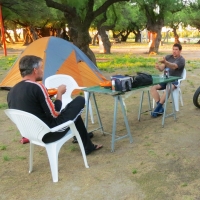 Once the tents are pitched, I cook pasta for the three of us while the men talk about motorcycles and all that is involved. It is a special way of talking, because it all happens without any noise. To attract attention Marko knocks on the table and once we look his way he tells his story like the best mime. It is very clear and it is not hard to imagine that he can make himself understood anywhere in the world with his sign language. With a map of the world on his phone, he shows us where he has been, where it is fun, how expensive gasoline is and where we must beware of corrupt policemen. The sun has already set when we yawn and make preparations to go to bed. We are the only guests at the campsite and share the field with four dogs. Just outside the gate of the camp some men walk in the shade and some cars drive passed slowly while the drivers look our way. I do not feel completely at ease and am quite happy with the watchdogs next to our tent. That night I will not wear earplugs, so I can hear the sounds around the tent. I realize how fortunate I am to be able to make that choice, imagine you are deaf!
Once the tents are pitched, I cook pasta for the three of us while the men talk about motorcycles and all that is involved. It is a special way of talking, because it all happens without any noise. To attract attention Marko knocks on the table and once we look his way he tells his story like the best mime. It is very clear and it is not hard to imagine that he can make himself understood anywhere in the world with his sign language. With a map of the world on his phone, he shows us where he has been, where it is fun, how expensive gasoline is and where we must beware of corrupt policemen. The sun has already set when we yawn and make preparations to go to bed. We are the only guests at the campsite and share the field with four dogs. Just outside the gate of the camp some men walk in the shade and some cars drive passed slowly while the drivers look our way. I do not feel completely at ease and am quite happy with the watchdogs next to our tent. That night I will not wear earplugs, so I can hear the sounds around the tent. I realize how fortunate I am to be able to make that choice, imagine you are deaf!
After a short night we wake up early the next morning. We do not have any food for breakfast, so we start packing right away. We say goodbye to Marko and go downtown to do some shopping. In a large supermarket we can find everything we need: bread, drinks, fresh fruit and vegetables. When we have also filled up our tanks we ride to Ruta 3. We want to cover some distance on the highway today.
We have not even left the city centre when we are stopped by the police. It looks like a routine check, because in front of us are another five cars. Two police officers ask to see our documents. It is not immediately clear what information they want from us and they seem to be somewhat angry that it is taking so long. Once they see that we are tourists, they have a little more patience and when they hear that we are from the Netherlands the expression on their faces changes. They know that country! And not, as we had expected, from soccer, but from our Queen Maxima who is originally from Argentina. Each of them tells how beautiful she is. They also make some remarks about our King, who apparently does not meet the Argentine beauty ideal. They then ask where we are going and where we have been. When we tell about our trip, a smile comes to their faces. “On these motorbikes to Ushuaia?” “And through the whole of Africa?” “That is impossible!?” Amazed, they walk round the bikes. They take out a photocamera and take pictures of us, the bikes and the policemen next to the bikes. Funny.
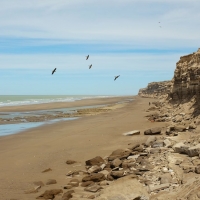 Just when we are on our way again, we are stopped again a few miles further. This time for a veterinary check. We know those from Botswana and Namibia. If we want to go to southern Argentina, we need to hand in all the meat, fruit and vegetables that we carry. We do not have any meat, but our bags are packed with the fruits and vegetables we bought only half an hour ago. Peter tries to evade the control by saying that he does not speak Spanish and he does not understand the officer. The tangerines are however in a transparent plastic bag on the back of his bike and very well visible. We cannot fool the policeman. We are not allowed to take the fruit, but we can eat it here. That sounds like a good plan, because we still did not have breakfast. Moments later we drive back to the policeman with only the peels of the bananas and tangerines. We hand over our last lemon, but we can keep it, just like the rest of our vegetables. We can go and open the throttle to finally start a long drive to the south.
Just when we are on our way again, we are stopped again a few miles further. This time for a veterinary check. We know those from Botswana and Namibia. If we want to go to southern Argentina, we need to hand in all the meat, fruit and vegetables that we carry. We do not have any meat, but our bags are packed with the fruits and vegetables we bought only half an hour ago. Peter tries to evade the control by saying that he does not speak Spanish and he does not understand the officer. The tangerines are however in a transparent plastic bag on the back of his bike and very well visible. We cannot fool the policeman. We are not allowed to take the fruit, but we can eat it here. That sounds like a good plan, because we still did not have breakfast. Moments later we drive back to the policeman with only the peels of the bananas and tangerines. We hand over our last lemon, but we can keep it, just like the rest of our vegetables. We can go and open the throttle to finally start a long drive to the south.
We follow Ruta 3. The highway runs parallel to the coast through an undulating dune area with lots of birds. We only see the sea for the first time when we arrive in El Condor after more than 300 km. It is a small town just south of Viedma. In summer it is probably pretty busy here, but as it is spring now the village looks like Zandvoort (a popular Dutch beach resort) on a Tuesday morning in autumn. All the restaurants are closed, the holiday homes are deserted and the shops on the boulevard are locked. The campsite is also deserted. Though this could also have something to do with the siesta, because it is half past three and the Argentine afternoon nap is not done yet. We walk around and find someone who tells us that the campsite is open, but the owner is sleeping. We take a chair, eat a sandwich and slowly begin to unpack our bags. At half past six the reception door opens and a sleepy man steps out to welcome us to his campsite. The siesta is over and El Condor wakes up for the second time that day.
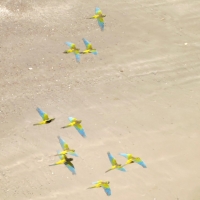 After dinner we take a walk on the beach and sit down in the sand. Although the temperature is not yet very tropical, the birds are. High in the sky is large groups burrowing parrots, a beautiful blue-green parrot. They make a lot of noise, so we hear them from afar. It is as if we are at an air show when we watch the birds through the binoculars when they fly from left to right. We stay until the sun sets and then crawl into the tent while the parrots continue their airshow tirelessly.
After dinner we take a walk on the beach and sit down in the sand. Although the temperature is not yet very tropical, the birds are. High in the sky is large groups burrowing parrots, a beautiful blue-green parrot. They make a lot of noise, so we hear them from afar. It is as if we are at an air show when we watch the birds through the binoculars when they fly from left to right. We stay until the sun sets and then crawl into the tent while the parrots continue their airshow tirelessly.
The next day we ride on Ruta 1 along the coast to the west. The route runs right along the ocean and follows the winding coastline. Previously this was the main road from El Condor to the west, but now most traffic follows a new shorter road little more inland. Great because that means there are no freight trucks on the road. The coastline consists of high cliffs, like the ones you can find in Normandy in France. The perfect place for the burrowing parrots who peck a hole in the soft rock for their nests. There are a lot of birds, even more than yesterday. Not surprising, as this is the largest parrot colony in the world(!) with more than 37,000 couples. From the top of the hills, we can see their colorful wings very well, although it is almost impossible to capture them in a photo because they fly very fast.
From El Condor the first few kilometers are on a tarmac road, but exactly when the road on the map changes from yellow to white, a gravel road begins. We drive right along the water and sometimes almost on the beach. On some parts there is a lot of sand on the road. As always I struggle in the sand. A few times I get off the bike angry and frustrated (rather than just drive through the sand as Peter does). But like the Dutch saying that you must endure some pain if you want to be beautiful, I should now just get it together and keep riding to be able to see the beautiful coastline and have lunch on a spectacular spot next to the sea. We sit down in the sand, enjoy the sun and see sea lions in the water below the high cliffs! After lunch we see a lot more unusual animals: a turtle, an armadillo (unfortunately a flat one) and guanacos, a kind of llama that crosses the road with graceful leaps. Very nice and all in all a wonderful route!
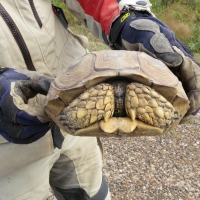 Covered in dust from the gravel road, we arrive in Las Grutas at the end of the day. Like El Condor it is a seaside resort that is very quiet at this time of year. We drive to ten different campsites, all of which are closed. Even at number eleven there is a big lock on the fence, but we do see are a tent. A cranky man agrees to let us in on the condition that we only stay one night. You got it, no problem!
Covered in dust from the gravel road, we arrive in Las Grutas at the end of the day. Like El Condor it is a seaside resort that is very quiet at this time of year. We drive to ten different campsites, all of which are closed. Even at number eleven there is a big lock on the fence, but we do see are a tent. A cranky man agrees to let us in on the condition that we only stay one night. You got it, no problem!
The next morning we get up early to leave the empty campsite. We still have to cover quite some distance before we arrive at Peninsula Valdés, a peninsula with a nature reserve that should be worth visiting. It will be our first tourist destination in a long time. We drive between the freight trucks on Ruta 3 southward. It is chilly and there is a strong wind. Especially the wind is annoying on our light motorbikes without windshield. We can barely keep our speed and bend over the tank as deep as possible to stay out of the wind. The motorbikes use a lot more fuel in this wind and at these speeds than usual. One litre of fuel only takes us 18 kilometers, while it usually brings us at least 30 kilometers further.
At one of the bigger petrol stations where we stop to refuel, we meet Charlie and Cecilia, the bikers from Singapore who we met in Buenos Aires earlier. Like us, they will go to the peninsula today. We drink a cup of coffee together and get on our bikes again at the same time. We will not ride to the peninsula together, because Charlie is a lot faster on his powerful BMW. We will probably see them again soon enough. We trudge further through the wind and from Puerto Madryn follow a provincial road to the peninsula. The wind pushes the motorbikes from left to right across the road. The road runs over the narrow strip of land and is flanked by vast fields with low bushes and the sea on both sides.
 Halfway we buy a ticket to enter the nature reserve and a little further we stop at the visitors center. It is a nice information center with large colored plates of the plants and animals that we can find on the peninsula. The animals cannot only be seen on land and in the air, but also in the water. The bay is visited by a lot of whales, on the beaches are sea lions and elephant seals and in the water are different species of dolphins and even orcas. We both have never seen orcas in the wild and would really like to see them. It is not quite the right season, but you never know.
Halfway we buy a ticket to enter the nature reserve and a little further we stop at the visitors center. It is a nice information center with large colored plates of the plants and animals that we can find on the peninsula. The animals cannot only be seen on land and in the air, but also in the water. The bay is visited by a lot of whales, on the beaches are sea lions and elephant seals and in the water are different species of dolphins and even orcas. We both have never seen orcas in the wild and would really like to see them. It is not quite the right season, but you never know.
We continue our way and arrive in Puerto Piramides, the only town on the peninsula. The campsite in town is closed, so we will spend the night in a hostel. As we drive around the small town along the hotels, restaurants and souvenir shops we see two people in the distance that are in the middle of the street waving at us: Charlie and Cecilia. Their big BMW is already parked in front of the hostel where there is still room for us. It is not very busy so we have an 8-person dormitory for the two of us. Within fifteen minutes our stuff is on all of the beds and in each outlet a device is charging.
As we walk to the communal living of the hostel, we are almost stunned by the strong garlic smell that comes from the kitchen. Cecilia is cooking. On the cutting board is a chicken that has been chopped to pieces and around it are bags with herbs and fresh vegetables. She has just chopped two entire bowls of garlic which she is now frying to sprinkle over the fried rice tonight. Cecilia gives everyone a taste of what she is making. Other guests who come to take a look in the kitchen, immediately get handed a plate with food. Refusing is not possible. But not smart either, because everything she makes is delicious! We are happy to share their food that night and fully enjoy the fried rice with garlic. During dinner we agree to ride together for a few days. Tomorrow we will first tour around the peninsula and then we will ride in the direction of San Carlos de Bariloche.
 The next morning we get up early. It is sunny and there is not much wind, so it is a nice day for a ride on the bikes. The roads on the peninsula are unpaved. Normally we drive those gravel roads with all of our luggage, but today we leave everything in the hostel. It is much nicer to ride with an even lighter bike. Charlie does not have so much experience driving on gravel roads, simply because there are only paved roads in Singapore. The gravel and sand roads that he has ridden during his trip in South America did not do him any good. It had been very hard to keep the heavy BMW, which weighs over 400kg with the luggage and Cecilia, upright. Not surprising when you consider that Charlie is just a little guy that can barely touch the floor when he is on the bike, even despite the lowered seat. Today is the perfect day to gain some more experience on gravel roads for all of the gravel roads that are yet to come in the south of Argentina and Chile.
The next morning we get up early. It is sunny and there is not much wind, so it is a nice day for a ride on the bikes. The roads on the peninsula are unpaved. Normally we drive those gravel roads with all of our luggage, but today we leave everything in the hostel. It is much nicer to ride with an even lighter bike. Charlie does not have so much experience driving on gravel roads, simply because there are only paved roads in Singapore. The gravel and sand roads that he has ridden during his trip in South America did not do him any good. It had been very hard to keep the heavy BMW, which weighs over 400kg with the luggage and Cecilia, upright. Not surprising when you consider that Charlie is just a little guy that can barely touch the floor when he is on the bike, even despite the lowered seat. Today is the perfect day to gain some more experience on gravel roads for all of the gravel roads that are yet to come in the south of Argentina and Chile.
The four of us leave the hostel and meander along the cliffs until we arrive at the first look out point. With the binoculars we see some whales in the distance, but they are so far away that we can not see them very good. At the second viewpoint we have more luck. A few hundred metres from the side we see a whale that sticks his nose out of the water and then quietly slides under water again. A few minutes later he comes back up again, blowing steam up in the air from his blowhole. A ritual that is repeated several times, and each time Cecilia emits a joyful cry.
We drive to another lookout point on the other side of the peninsula. At the information desk we were told that the best chance to see orcas is at high tide. The orcas then swim close to shore to steal a small see lion from the beach. If we go now, we are just in time for “orca-lunchtime”. We follow the gravel road to the east. The road is in good condition and almost empty. There are some gentle curves in the road we can take at full speed without any difficulty. Lovely. 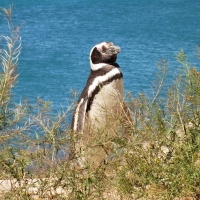 Charlie also sits on his motorbike relaxed and has enough confidence to even make some movies with his helmet camera. Although we do need to stay alert because every so often a Rhea (the South American version of the ostrich) or Gaunaco crosses the road. The Rheas blend into the landscape and are almost invisible. The Gaunaco are easier to find, because they are often on top of the hills next to the road. But when there is one that crosses the road, you better stop because they always have some friends that also want to get to the other side.
Charlie also sits on his motorbike relaxed and has enough confidence to even make some movies with his helmet camera. Although we do need to stay alert because every so often a Rhea (the South American version of the ostrich) or Gaunaco crosses the road. The Rheas blend into the landscape and are almost invisible. The Gaunaco are easier to find, because they are often on top of the hills next to the road. But when there is one that crosses the road, you better stop because they always have some friends that also want to get to the other side.
We park the bikes at the second lookout where a large group of Magellanic penguins lives. It is a small species of penguin that looks like the black-footed penguins that we saw in South Africa. They stand on the waterfront, waddle up the steep dune towards their den or sit in the sun to dry. Great little animals. Meanwhile we scour the water with the binoculars, but see no fins in the water. We might have more luck at the next lookout. We are already back at the bikes when Peter suddenly shouts: “Hey ORCAS!”. He snatches the binoculars from my hands and runs back to the lookout. While the other tourists are with their backs toward the water to watch the penguins, Peter sees a huge killer whale beaching and moving in the direction of a small sea lion. We run after Peter and take turns looking through the binoculars at the big black and white bodies that glide smoothly through the water. They circle next to the sea lions for a long time until they have had enough and leave towards the open sea. Very cool to see and a checkmark on my wish list. We were very lucky to see them! At the last viewpoint we see a large group of sea lions and elephant seals. Especially the elephant seals are enormous. They look a bit helpless on the beach, like a big blob of mud washed up on the beach. Once in the water this is completely different and they all of a sudden swim with ease rapidly through the water.
 At the end of the day it is again very windy. With the wind in our backs and a big smile on our faces we drive on the gravel roads back to the hostel. Charlie clearly also enjoys the ride and is very happy with the 220km gravel experience he has gained today. We stay for one extra day on the peninsula and then hit the road again. From the peninsula we drive inland to the west of Argentina. Away from the coast and towards the Andes. Today the wind blows from the west, which means that we ride directly into it. Charlie is left unaffected by the wind behind his windshield, but we again lie with our noses on the tanks to keep momentum. The first kilometers Charlie rides behind us, but he soon overtakes us. We will see them again at the next gas station.
At the end of the day it is again very windy. With the wind in our backs and a big smile on our faces we drive on the gravel roads back to the hostel. Charlie clearly also enjoys the ride and is very happy with the 220km gravel experience he has gained today. We stay for one extra day on the peninsula and then hit the road again. From the peninsula we drive inland to the west of Argentina. Away from the coast and towards the Andes. Today the wind blows from the west, which means that we ride directly into it. Charlie is left unaffected by the wind behind his windshield, but we again lie with our noses on the tanks to keep momentum. The first kilometers Charlie rides behind us, but he soon overtakes us. We will see them again at the next gas station.
The landscape is flat like the pampas we passed earlier, but the green meadows have now been replaced by a dry, desolate landscape. The colors are very nice. The low bushes bloom yellow, the high rock walls are deep red and the lake we pass at the end of the day is mint green. Very special. On the high dam next to the lake Charlie and Cecilia are waiting for us. We drive down into the valley and find a camping spot at the campsite in Dique Villa Florentine Amerghine, a lovely town in the shadow of the dam.
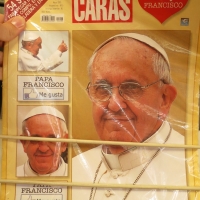 Once the tents are pitched, we do some shopping at a local shop. On the counter is a sticker book of one of the most famous Argentines of this time. And that is not Messi, as you might expect, but Pope Franciscus. The current Pope is not only the most liberal and progressive pope since a long time, but also the first pope from South America. And in Argentina they are very proud of ’their’ pope. He has his own sticker book and his image is on t-shirts and posters. The Catholic Church also has a lot more members here than in northern Europe. Even in the smallest villages you can find a church, always very well maintained, and along the way we often pass small altars that are covered in colourful flowers.
Once the tents are pitched, we do some shopping at a local shop. On the counter is a sticker book of one of the most famous Argentines of this time. And that is not Messi, as you might expect, but Pope Franciscus. The current Pope is not only the most liberal and progressive pope since a long time, but also the first pope from South America. And in Argentina they are very proud of ’their’ pope. He has his own sticker book and his image is on t-shirts and posters. The Catholic Church also has a lot more members here than in northern Europe. Even in the smallest villages you can find a church, always very well maintained, and along the way we often pass small altars that are covered in colourful flowers.
From the small village at the dam we drive a little further to the west the next day. It is a long, boring day into the wind, during which we see Charlie and Cecilia only when we take fuel. At the end of the day I suddenly hear “WOW, look at that” over the intercom. In the distance we see snowy peaks! The view is instantly more interesting and the route a lot less boring. When we stop at the gas station in Tecka we see our friends again. We are tired and unanimously decide that we do not continue riding today. 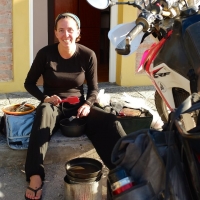 There is no camping in the village, but we can stay in the rooms at the fuel station. We throw our bags in the beautiful room and cook some pasta on the sidewalk in front of the hotel. Tomorrow we will go in the direction of those snowy peaks!
There is no camping in the village, but we can stay in the rooms at the fuel station. We throw our bags in the beautiful room and cook some pasta on the sidewalk in front of the hotel. Tomorrow we will go in the direction of those snowy peaks!
Distance travelled to Tecka: 35,507 km (22,063 miles)
Click here to view the photos.
Previous story “Welcome to Argentina” – Next story “White peaks“





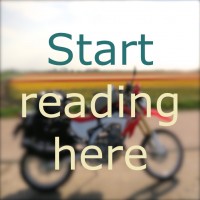


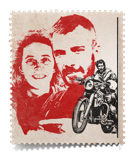
Wowwowwow orka’s, roze lepelaars en gordeldieren…gaahaaf!
Zo leuk om nu over ons geliefde zuid amerika te lezen!
Veel plezier en kom maar gauw hierheen
Prachtige verhalen !! xxx
Wat mooi toch allemaal! Reuze benieuwd naar de Andes-plaatjes straks. Xxx